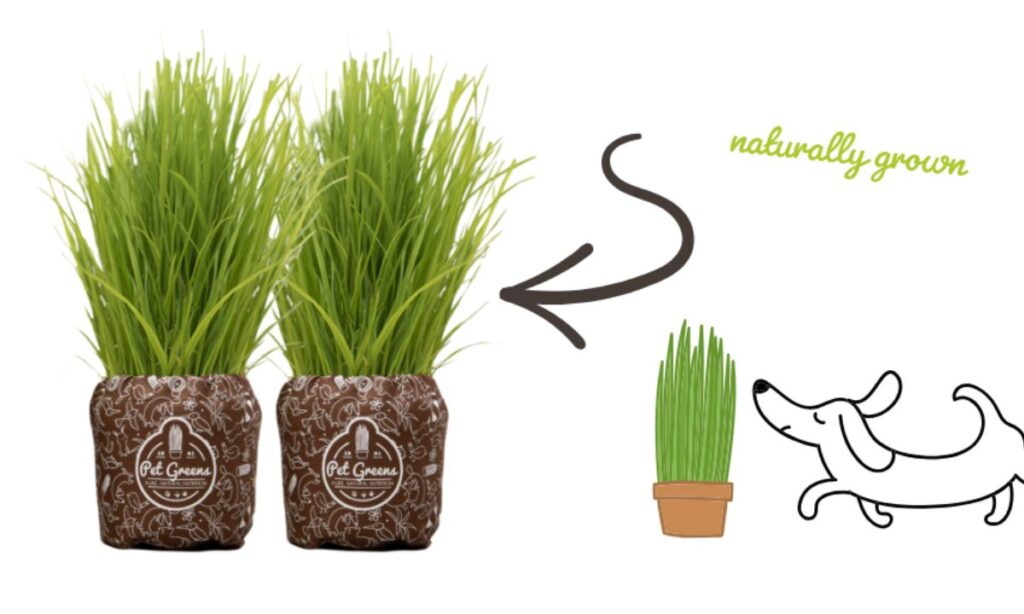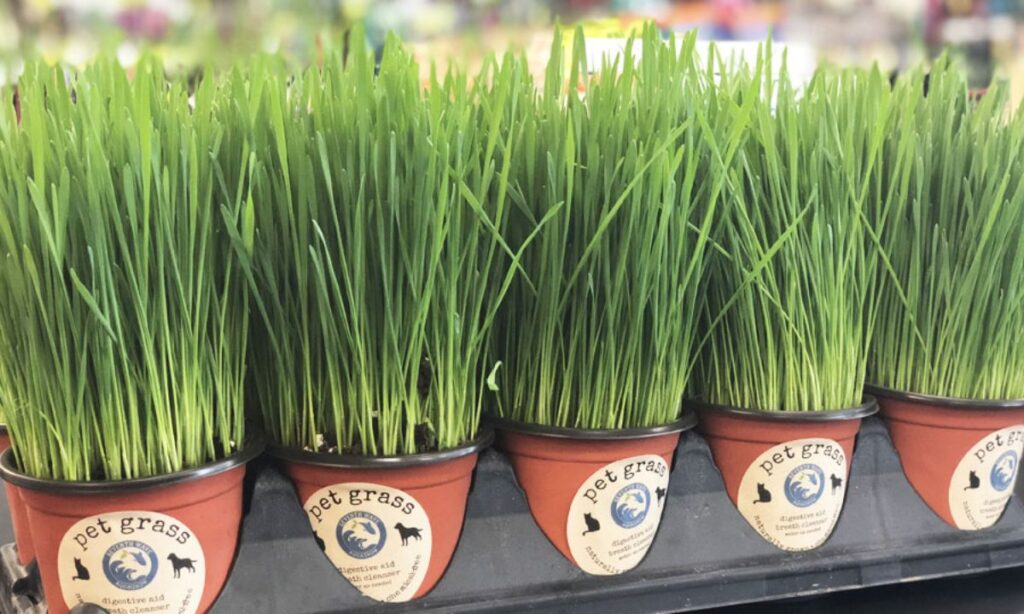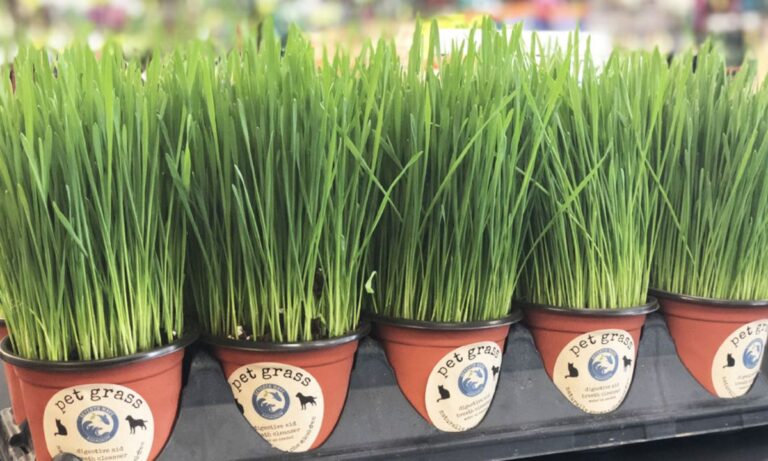Pet grass refers to a variety of grasses that are cultivated specifically for pets to eat. Unlike regular grass found in yards or fields, pet grass is safe, nutritious, and can be grown indoors or outdoors for easy access.
The most common types of pet grass include wheatgrass, oatgrass, and barley grass, which are packed with essential nutrients like vitamins, minerals, and fiber. Pets like cats, dogs, and even rabbits may instinctively eat grass for its digestive benefits.
Pet grass provides a natural and healthy way for your pets to get some greens, especially since many pets lack access to fresh plants in their daily diet. It’s a safe alternative to wild grass, which may contain harmful chemicals, pesticides, or diseases.
Read This Blog; Why Do Dogs Lick You When You Pet Them
Pet Grass Wheatgrass Benefits for Dogs & Cats
Wheatgrass is a powerful and highly nutritious type of pet grass. It is packed with chlorophyll, fiber, antioxidants, and essential vitamins such as A, C, and E.
These nutrients are essential for maintaining overall health in both dogs and cats. Wheatgrass is especially beneficial for improving digestion, reducing inflammation, and detoxifying the body.
Here are some key wheatgrass benefits for pets:
- Digestive Health: Wheatgrass helps in easing digestive issues, such as constipation and indigestion. The fiber content promotes smooth digestion and helps in eliminating hairballs in cats.
- Natural Detoxifier: Wheatgrass contains chlorophyll, which is known to help detoxify the liver and other organs by flushing out toxins. This is particularly beneficial for pets exposed to environmental toxins or those who have digestive issues.
- Boosts Immune System: The antioxidants in wheatgrass can help strengthen the immune system of pets, protecting them from illnesses.
- Alkalizing Effect: Wheatgrass helps to balance the pH levels in the body, creating an alkaline environment which can be beneficial for pets with digestive or inflammatory
What Exactly is Wheatgrass?
Wheatgrass is the young grass of the wheat plant (Triticum aestivum). It’s harvested before the wheat plant starts to develop seeds and grains. Wheatgrass is packed with essential nutrients, including chlorophyll, vitamins A, C, and E, and minerals such as iron, calcium, and magnesium.
It is often consumed as a health food for humans and pets alike due to its numerous health benefits. Wheatgrass is a rich source of enzymes, which can aid in digestion. Its high fiber content is especially helpful for pets who suffer from constipation or need assistance in removing hairballs.
It’s also rich in amino acids that help support muscle and tissue health. Wheatgrass is easy to grow and can be cultivated indoors in containers, making it an accessible and natural food source for your pet. It has a mild, grass-like taste that many pets find appealing,
Why Offer Wheatgrass to Your Dog or Cat?

There are several reasons why you might consider offering wheatgrass to your dog or cat:
- Natural Remedy for Hairballs: Wheatgrass is often recommended for cats because it helps them pass hairballs more easily. The fiber in the grass aids in digestion, and when your cat consumes it, it helps push hairballs through their digestive tract.
- Improves Digestion: Wheatgrass is a natural digestive aid. Both dogs and cats can benefit from the high fiber content, which supports smooth and regular bowel movements. This is particularly helpful for pets who suffer from constipation or occasional digestive issues.
- Boosts Energy Levels: Because wheatgrass is packed with vitamins and minerals, it provides a natural energy boost. Cats and dogs who are often sluggish or lacking energy can feel revitalized after eating wheatgrass.
- Detoxifying Effects: The chlorophyll in wheatgrass has natural detoxifying properties. It helps flush out toxins from your pet’s system, improving overall health and wellness.
- Improves Breath and Oral Health: Wheatgrass can also help with your pet’s oral health. When chewed, it can help to clean your pet’s teeth and freshen their breath, contributing to better dental hygiene.
How to Feed Wheatgrass to Your Dog or Cat
Feeding wheatgrass to your dog or cat is easy and can be done in a few simple steps. Here’s how to introduce wheatgrass into your pet’s diet:
- Grow Wheatgrass Indoors: You can easily grow wheatgrass in small pots or containers indoors. Make sure it gets adequate sunlight, and water it regularly to keep the soil moist but not soggy. Wheatgrass typically takes around 7-10 days to grow to a height where it’s ready to eat.
- Offer Fresh Wheatgrass: Once your wheatgrass has grown to a suitable height (usually 4-6 inches), you can offer it to your pet. Simply place the container on the floor or in an accessible spot where your pet can freely nibble on it.
- Monitor Your Pet’s Intake: While wheatgrass is generally safe, it’s always best to introduce it gradually. Observe your pet to ensure they aren’t overeating it, which could cause mild digestive upset.
- Serve as a Treat: You can also cut fresh wheatgrass into small, bite-sized pieces and mix it with your pet’s regular food. Alternatively, it can be served as a snack or treat.
- Commercial Wheatgrass Products: If you don’t have the time or space to grow wheatgrass, there are commercial wheatgrass products available for pets. These come in the form of powders, capsules, or even freeze-dried options that are easy to mix into your pet’s food.
Harvest and Storage of Wheatgrass for Pets

Once your wheatgrass has grown to an appropriate size (about 4-6 inches), you can begin to harvest it for your pet. Here’s how to do it:
- How to Harvest: Using scissors or garden shears, cut the wheatgrass just above the soil line. It’s best to trim it in small amounts, allowing the remaining grass to continue growing.
- Storage: If you’ve grown a lot of wheatgrass and don’t want it to go to waste, you can store any unused grass. Simply place it in a plastic bag or airtight container and keep it in the refrigerator for up to one week. You can also freeze the grass in small portions to use later.
- Regrowth: Wheatgrass will regrow after being cut. Simply water it and allow it to grow back for further harvests.
Frequently Asked Questions
Can I grow wheatgrass for my dog or cat?
Yes, you can grow wheatgrass indoors or outdoors to offer your pet a fresh, nutritious treat.
Is wheatgrass safe for pets to eat?
Yes, wheatgrass is completely safe for both dogs and cats. It’s packed with beneficial nutrients and supports digestive health.
How often can I feed wheatgrass to my pet?
Wheatgrass can be given to your pet daily, but it should be offered in moderation to avoid digestive upset.
Can wheatgrass help with hairballs in cats?
Yes, wheatgrass is excellent for helping cats pass hairballs. The fiber content promotes smoother digestion and reduces the risk of hairballs.
Conclusion
In conclusion, wheatgrass is an incredibly beneficial addition to your pet’s diet. It provides a natural, nutritious, and safe way to boost your pet’s health. From improving digestion to detoxifying their system, offering wheatgrass can help improve your pet’s overall well-being. It’s also easy to grow and serves as an environmentally-friendly way to provide fresh greens for your furry friend.
Whether you choose to grow it yourself or purchase ready-to-use products, incorporating wheatgrass into your pet’s routine can make a world of difference. It’s not only a healthy treat but also a natural remedy for many common pet health issues, like hairballs, poor digestion, and low energy levels. So, if you haven’t yet introduced wheatgrass to your pet, it’s definitely worth considering for their long-term health.
